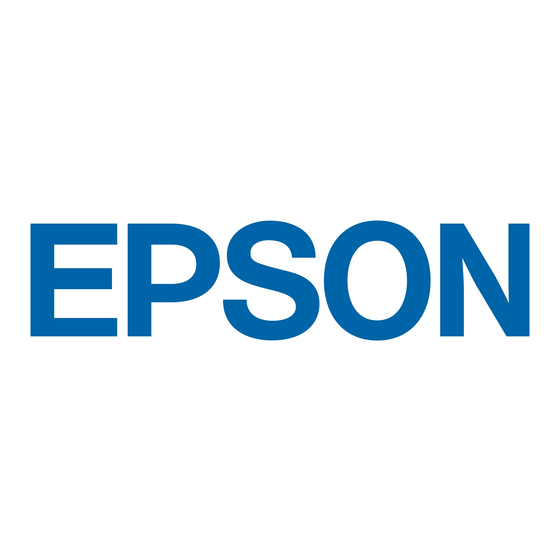
Inhaltsverzeichnis
Werbung
Verfügbare Sprachen
Verfügbare Sprachen
Quicklinks
®
IEEE 1394 I/F Card
English
English
.............
............. 1 1 1 1
English
English
.............
.............
Deutsch .............
Deutsch
............. 13
Deutsch
Deutsch
.............
.............
Français .............
Français
............. 25
Français
Français
.............
.............
Español
Español
.............
............. 37
Español
Español
.............
.............
Italiano
Italiano
............. 49
.............
Italiano
Italiano
.............
.............
Português.............
Português
............. 61
Português
Português
.............
.............
13
13
13
25
25
25
37
37
37
49
49
49
61
61
61
4020112-00
C01
Werbung
Kapitel
Inhaltsverzeichnis

Inhaltszusammenfassung für Epson IEEE 1394
- Seite 15 Spezifikationen..........22 IEEE 1394-Schnittstellenkarte ......22...
-
Seite 16: Einführung
Einführung Dieses Handbuch liefert Informationen zur Verwendung der IEEE 1394- Schnittstellenkarte Typ B bei Anschluss an einen Drucker. Leistungsmerkmale Diese Schnittstellenkarte entspricht dem IEEE 1394-Standard und weist folgende Leistungsmerkmale auf: Die Schnittstellenkarte kann an jeden Computer, der mit einem von ®... -
Seite 17: Einschränkungen
PCI-Schnittstellenkarte ausgerüstet, für den Apple Computer die Garantie übernimmt. Einschränkungen Der IEEE 1394-Port verfügt über sechs Stifte. Stellen Sie sicher, dass Sie ein geeignete Schnittstellenkabel mit jeweils sechs Stiften an jedem Kabelende verwenden. Schließen Sie niemals zwei Computer gleichzeitig an diese Schnittstelle an. -
Seite 18: Drucker Über Die Schnittstellenkarte An Den Computer Anschließen
Wenn Sie den Drucker direkt an den Computer anschließen Verbinden Sie einen Anschluss mit dem IEEE 1394 (FireWire)-Port des Computers. Verbinden Sie den anderen Anschluss mit einem der IEEE 1394- Anschlüsse der in dem Drucker installierten Schnittstellenkarte (Sie können einen beliebigen Anschluss auswählen). -
Seite 19: Wenn Sie Den Drucker An Einen Computer Anschließen, An Den Bereits Andere Ieee 1394-Geräte Angeschlossen Sind
Drucker Gerät Hinweis: Verwenden Sie zum Anschluss der Schnittstelle an ein IEEE 1394-Gerät immer ein geeignetes Kabel mit jeweils sechs Stiften an jedem Ende. Bei Verwendung eines 6:4-Adapterkabels treten möglicherweise Betriebsstörungen auf. Verbinden Sie das Kabel mit einem verfügbaren IEEE 1394-Anschluss, wenn noch andere IEEE 1394-Geräte an den Drucker angeschlossen... -
Seite 20: Installation Unter Windows 2000
Hardware gefunden nicht angezeigt wird, wurde der Drucker unter Windows 2000 nicht korrekt erkannt. Überprüfen Sie in diesem Fall die Einstellungen für den IEEE 1394-Port unter Windows 2000, die Kabelverbindungen und die Stromversorgung des Druckers. Wählen Sie die Option Nach dem besten Treiber für das Gerät suchen (empfohlen) aus, und klicken Sie auf die Schaltfläche... -
Seite 21: Installation Unter Windows Me
Sie anschließend auf OK. (E steht für die Laufwerkskennung Ihres CD-ROM-Laufwerks und kann auch anders lauten.) 11. Stellen Sie sicher, dass der Titel des Dialogfelds EPSON 1394 Printer IEEE 1394 SBP2 Device lautet, und klicken Sie anschließend auf die Schaltfläche Weiter. -
Seite 22: Sicherstellen, Dass Der Ieee 1394-Treiber Korrekt Unter Windows Me Bzw. 2000 Installiert Ist
Me bzw. 2000 installiert ist Wenn die Installation der Druckersoftware abgeschlossen ist, vergewissern Sie sich, dass der IEEE 1394-Treiber korrekt installiert ist. Klicken Sie auf Start, zeigen Sie auf Einstellungen, und klicken Sie auf Drucker. Vergewissern Sie sich, dass das Symbol für Ihren Drucker im Ordner Drucker angezeigt wird. -
Seite 23: Druckersoftware Auf Einem Macintosh Installieren
Legen Sie die mit Ihrem Drucker mitgelieferte CD-ROM mit der Druckersoftware in das CD-ROM-Laufwerk ein. Der Inhalt der CD- ROM mit der Druckersoftware wird automatisch angezeigt. Doppelklicken Sie auf EPSON STYLUS PRO 10000 bzw. EPSON STYLUS PRO 10000CF und anschließend auf den Ordner zur Installation der Druckersoftware. -
Seite 24: Drucker In Der Auswahl Auswählen
Ist der Hintergrunddruck eingeschaltet, können Sie auf Ihrem Macintosh weiterarbeiten, während er im Hintergrund ein Dokument zum Ausdrucken vorbereitet. Der Hintergrunddruck muss eingeschaltet sein, um mit dem Utility EPSON Monitor 3 Druckaufträge verwalten zu können. Schließen Sie die Auswahl. Spezifikationen... -
Seite 25: Stift-Belegung
Stift-Belegung Stift- Signal- Funktion Nummer Name Kabel-Stromversorgung Kabel-Masse TPB* Strobe während des Empfangs, Daten während der Übertragung (symmetrisches Paar) TPA* Daten während des Empfangs, Strobe während der Übertragung (symmetrisches Paar) Leistungsklasse Leistungsklassen-Code 100 Keine externe Stromzufuhr Mit Repeat-Funktion mit Bus-Leistung ausgerüstet Jumper Jumper Standardposition... -
Seite 26: Dip-Schalter
DIP Schalter Der IEEE 1394-Betriebsmodus wird über den DIP-Schalter 10 eingestellt. Stellen Sie den DIP-Schalter in die erforderliche Position. Hinweis: Normalerweise muss die Position des DIP-Schalters 10 nicht geändert werden. Er wird unter Windows 2000/ Windows Me und auf Macintosh-Systemen auf EIN für den erweiterten Modus gestellt. - Seite 76 Printed in Japan xx.xx-xx...



